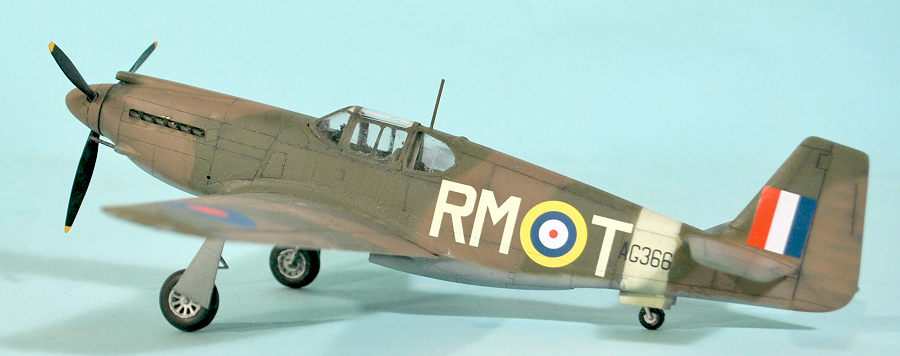
Halberd Models 1/48 Mustang I
| KIT #: | |
| PRICE: | $55.00 |
| DECALS: | Two options |
| REVIEWER: | Tom Cleaver |
| NOTES: | Resin kit |

| HISTORY |
The True Story of How The Mustang Was Created:
In October 1981, Edgar Schmued came out to the Planes of Fame Air Museum to take part in a program celebrating the 40th anniversary of the first flight of his most famous design, the North American P-51 Mustang. At the event, he was asked if it was really true that the Mustang had been designed and built in 100 days.
He answered, “The Mustang prototype was indeed built in 100 days. But I had been designing it for five years.” The “myth of the Mustang” is exactly that. A myth. Here’s the real story:
There is always one part of a myth that is true, and it is true that, in the summer of 1940, the British Purchasing Commission approached James “Dutch” Kindelberger, president of North American Aviation, with a proposal for the then little-known company to produce license-built copies of the Curtiss P-40, a fighter developed from the P-36, with which the British planned to equip the RAF. Kindelberger turned them down, saying he didn’t want to produce an “obsolete airplane” and suggesting to them that his company could deliver a world-beating fighter of original design.
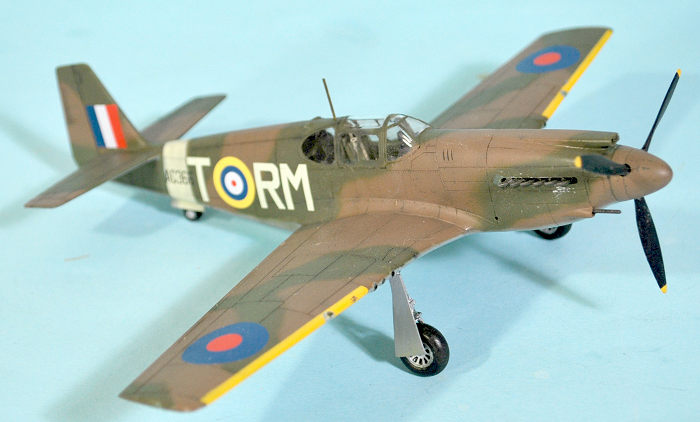 Dutch
Kindelberger didn’t end up running North American because he was a dummy.
Like an attorney who never asks a question in court he doesn’t already know
the answer to, when Kindelberger promised that North American could deliver
a world-beating fighter of original design, he’d already seen the design,
many times.
Dutch
Kindelberger didn’t end up running North American because he was a dummy.
Like an attorney who never asks a question in court he doesn’t already know
the answer to, when Kindelberger promised that North American could deliver
a world-beating fighter of original design, he’d already seen the design,
many times.
Born in 1901, Edgar Schmued fell in love with aviation when he saw an airplane fly in his native Germany at age eight. From then on, he was dedicated to the idea of becoming an aviation engineer. Self-taught, he became an apprentice in a small aircraft engine manufacturing company during the last year of World War I. With the Versailles Treating having cripped aviation development in postwar Germany, he left for Brazil in 1925 and took a job with the General Aviation Company, the aviation branch of General Motors Corporation’s Brazilian subsidiary. He built a reputation for solid work, and in 1931 he was brought to the U.S. by General Motors, where he achieved his dream of becoming an aircraft designer at the Fokker Aircraft Corporation of America, now owned by GM.
In 1934, GM sold Fokker to the North American Aviation holding company, which had been founded in 1928 to buy and sell interests in airlines and other aviation-related companies. The Air Mail Act of 1934 ended such companies; NAA became an aircraft manufacturer with the acquisition of Fokker, with James H. “Dutch” Kindelberger recruited from Douglas to run the new company.
Kindelberger moved the company headquarters from Maryland to Los Angeles. At that time, took a position with Bellanca in New York. After a few months, Schmued rejoined NAA, since Kindelberger was looking for young designers. Schmued started work as a preliminary design engineer. Over the next several years, he was involved with design of the NA-16 trainer that became the BC-1 and led to the famous T-6 Texan trainer series. Schmued ‘s first foray into fighter design was the NA-50, a single-seater based on the T-6 trainer, 50 of which North American sold to the Peruvian Air Force.
Kindelberger managed to convince the Army Air Corps to let his design team inspect and disassemble the first Messerschmitt Bf-109 to arrive in the United States following its capture in the Spanish Civil War. This connection to the Bf-109, and the later similarity of the early P-51 to the German fighter led to an “uban myth” that Schmued had worked for Messerschmitt. However, he did put the knowledge he gained from studying the Bf-109 to use in his ongoing “side hobby” of designing a fighter that would be “right,” as he explained later. The information he gained from studying the Bf-109 led to a complete redesign of what he had been playing with during his off hours since 1937, modifying the design to promote ease of mass production.
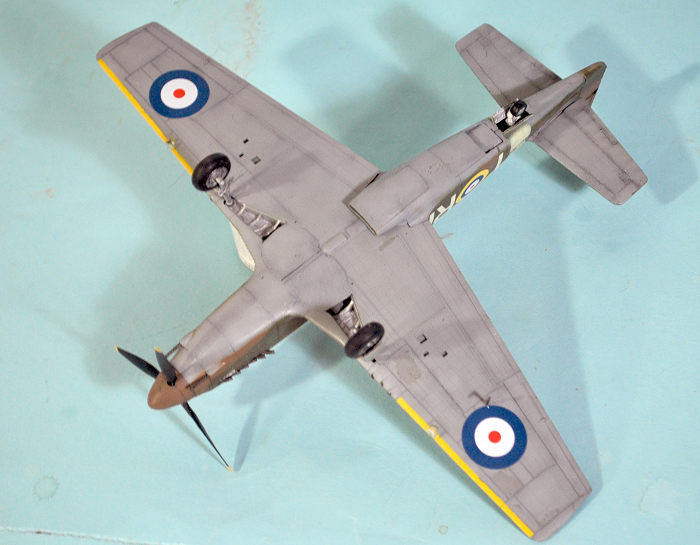 When
the British Purchasing Commission came calling with the offer to build P-40s
under license and Kindelberger offered a totally new fighter instead, he
knew all about Schmued’s “hobby.”
When
the British Purchasing Commission came calling with the offer to build P-40s
under license and Kindelberger offered a totally new fighter instead, he
knew all about Schmued’s “hobby.”
The British commission approved the detailed design drawings and signed a contract to start the Mustang project on May 4, 1940, ordering 320 on May 29, 1940. The contract stipulated armament of four .303 in machine guns as used on the Tomahawk, a unit cost of no more than $40,000, and delivery of the first production aircraft by January 1941.
Curtiss engineers accused NAA of plagiarism regarding the engine cooling system, which took advantage of he Meredith effect, in which heated air exited the radiator with a slight amount of jet thrust. Because NAA lacked a suitable wind tunnel to test this feature, it used the wind tunnel at Cal Tech, which led to some controversy over whether the Mustang's cooling system aerodynamics were developed by Edgar Schmued or by Curtiss, since NAA had purchased the complete set of P-40 and XP-46 wind tunnel data and flight test reports. However, Schmued’s design was far beyond anything that had started life in Buffalo.
The result was the NA-73, named Mustang, an airplane that equaled the performance of the Spitfire, with the range to fly into Germany from Britain on internal fuel. Its only problem was that it was powered by an Allison V-1710 engine without a supercharger, limiting its high altitude performance.
In September 1940, a further 300 NA-73s were ordered by the British. To ensure uninterrupted delivery, Colonel Oliver P. Echols arranged with the Anglo-French Purchasing Commission to deliver the aircraft and NAA gave two examples (41-038 and 41-039) to the USAAF for evaluation; they were still sitting in the back of a hangar at Wright Field, untouched since delivery, on December 8, 1941.
The first squadron of Mustang Mk Is entered service in January 1942, with 26 Squadron RAF. Due to poor high-altitude performance, the Mustangs were used by Army Co-operation Command. On May 10, 1942, Mustangs first flew over France, near Berck-sur-Mer. On July 27, 1942, 16 RAF Mustangs flew their first long-range reconnaissance mission over Germany. During the amphibious Dieppe Raid on August 19, 1942, four British and Canadian Mustang squadrons saw action covering the raid. During the first 18 months operations, Mustang Mk.Is destroyed or heavily damaged 200 locomotives, over 200 canal barges, and an unknown number of enemy aircraft parked on the ground, for a loss of eight Mustangs. The last Mustang Is were flown operationally by 26 Squaxdron in April 1945.
| THE KIT |
Pretty much every modeler who likes the early Mustangs has wished that Accurate Miniatures had started their series of Allison Mustangs with the Mk.I, but the closest anyone got to turning an A-M kit into the first Mustang was done using a resin set from Ultracast that changed the wing armament.
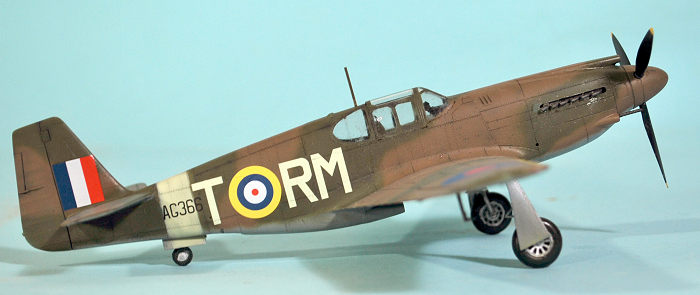 This
Mustang I from Halberd Models in Ukraine is the first all-Mustang I kit in 1/48.
It includes all the detail differences that distinguish the first Mustang from
the rest, including a smaller radiator cooling intake as well as the gun
armament.
This
Mustang I from Halberd Models in Ukraine is the first all-Mustang I kit in 1/48.
It includes all the detail differences that distinguish the first Mustang from
the rest, including a smaller radiator cooling intake as well as the gun
armament.
The kit is based on the Accurate Miniatures kit, and is both simple and highly detailed. Using resin casting, there are only some 30 parts in the entire assembly. The cockpit side detail is molded into the fuselage halves, and the wing is one piece; the only “mistake” is that the wheel well was not corrected in the outer area. The kit features superb, very petite, surface detail. The cast resin canopy is very clear, but cannot be opened.
Decals are provided for a Mustang I operated by 414 Squadron RAF, and a Mustang I provided to the Red Air Force for evaluation.
| CONSTRUCTION |
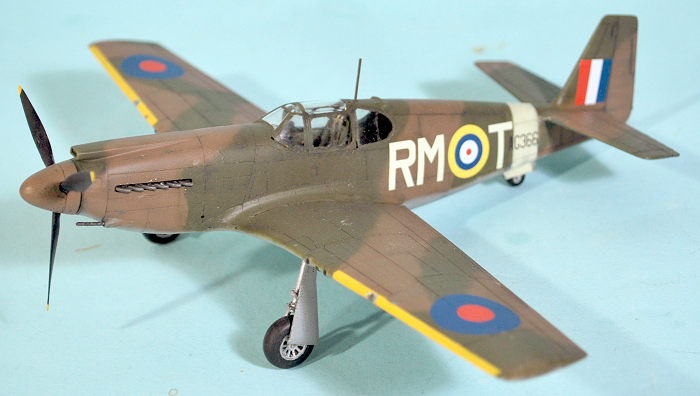 I began
by painting all the cockpit parts with Interior Green, and then painting all the
side panel details. I also made seat armor using 5 mil Evergreen sheet. I used a
set of Eduard photo-etch RAF seatbelts as the one non-OOB part in the project.
I began
by painting all the cockpit parts with Interior Green, and then painting all the
side panel details. I also made seat armor using 5 mil Evergreen sheet. I used a
set of Eduard photo-etch RAF seatbelts as the one non-OOB part in the project.
The Allison Mustangs have the wheel well main doors raised when on the ground, so I glued those in position. They fit much better than the plastic parts in an A-M kit if you do the same. When I assembled the fuselage, I found the centerline seam needed filler, for which I used Mr. Surfacer 500.
When attaching the wing, you must be careful that everything fits right, so test-fitting is crucial. Once you apply cyanoacylate glue, there won’t be a lot of fiddling to get things in position. Following that, I attached the horizontal stabilizers and finished with the canopy, which I attached with Micro Krystal Klear white glue to avoid any possibility of fogging.
| COLORS & MARKINGS |
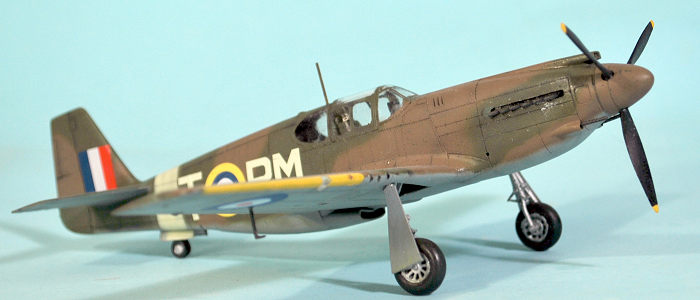 I wanted
to do this Mustang I in the original factory paint scheme, which was DuPont Dark
Earth and Dark Green on the upper surface and “Sky Grey” on the lower. I used
Mr. Color acrylic lacquer Dark Earth, RAF Dak Green and Medium Sea Grey for
these colors. The leading edge Yellow ID stripes that were added after the first
airplanes entered service was done with Tamiya Flat Yellow.
I wanted
to do this Mustang I in the original factory paint scheme, which was DuPont Dark
Earth and Dark Green on the upper surface and “Sky Grey” on the lower. I used
Mr. Color acrylic lacquer Dark Earth, RAF Dak Green and Medium Sea Grey for
these colors. The leading edge Yellow ID stripes that were added after the first
airplanes entered service was done with Tamiya Flat Yellow.
I used the kit decals, since they accurately portrayed the insignia painted on at the factory, which used prewar RAF “bright” insignia colors. Mustang I’s remained in the factory scheme for quite some time after the changeover in insignia in May 1942 and despite the fact the camouflage colors had changed in August 1941. Starting in the fall of 1942, the Dark Earth was overpainted with Ocean Grey at the Squadron level, and the final 300 Mustang Is of the second batch came in “U.S. equivalent” colors of Sea Grey and Olive Drab upper surfaces and the Sky Grey still on the lower surface.
I attached the landing gear and prop and unmasked the canopy.
| CONCLUSIONS |
As a Mustang fan(atic), it’s nice to have an accurate model of the first Mustang in my collection now. Halberd also releases this kit with the USAAF markings of the two XP-51s. Now if they would just modify the fuselage and canopy to do the NA-73...
Recommended for all Mustang fans who have experience with a full resin kit.
Review kit courtesy of all you book buyers.
7 December 2023
Copyright ModelingMadness.com. All rights reserved. No reproduction in part or in whole without express permission from the editor.
If you would like your product reviewed fairly and fairly quickly, please contact the editor or see other details in the Note to Contributors.